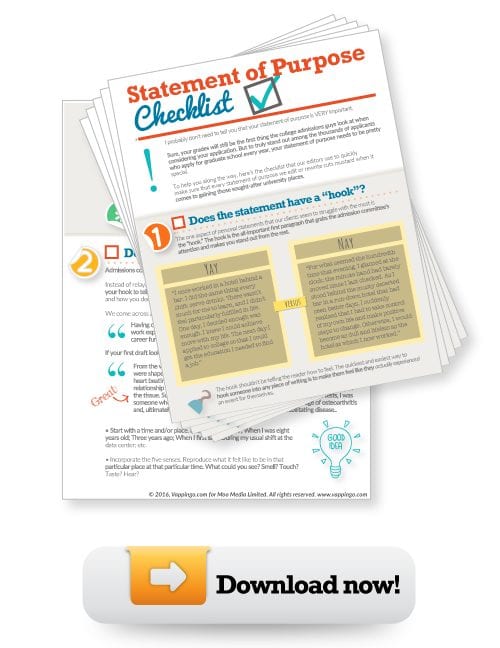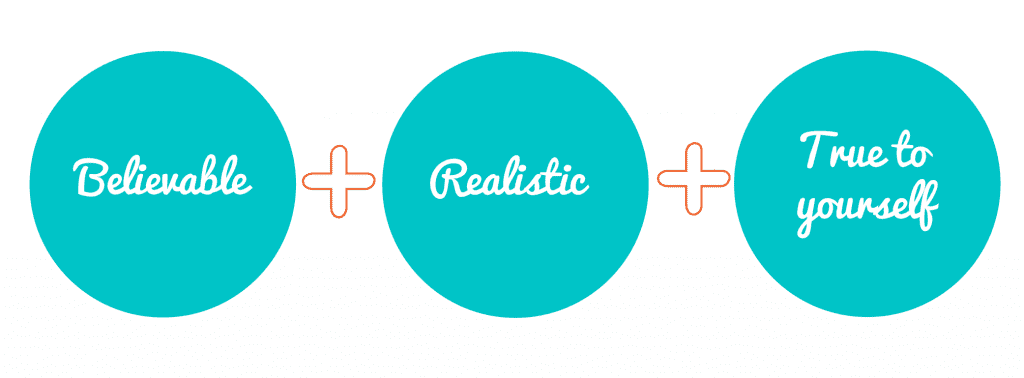We have reviewed thousands of statements of purpose and know what it takes to write a statement of purpose that gets students into the top programs. Get your hands on the very same statement of purpose checklist we use. That way, you’ll know EXACTLY how to write a statement that gets you into grad school.

I probably don’t need to tell you that writing a great statement of purpose (SOP) is HUGE.
In the post-COVID era, universities have seen a record increase in the number of students applying for admission.
Sure, your grades are the first thing the college admissions guys look at when considering your application. But to stand out among the thousands of applicants who apply for graduate school every year, your statement of purpose needs to be polished, coherent, and remarkable.
Writing a fantastic SOP may seem like an uphill struggle; however, it’s much simpler than you think.
To help you along the way, here’s the checklist that our editors use to quickly ensure that every statement of purpose we edit or rewrite cuts the mustard. Once you have familiarized yourself with the basic content requirements, read our guide on formatting a statement of purpose.
Before we go any further, if you have been asked to write a personal statement, this is not the guide for you. Take a look at our overview of the differences between a personal statement and a statement of purpose first.
How to Write a Statement of Purpose: A Killer Checklist
1) Does the SOP have a “hook”?
The one aspect of SOPs that our clients seem to struggle with the most in the process of learning how to write a statement of purpose is the “hook.”
The hook is the all-important first paragraph that grabs the admission committee members’ attention and makes you stand out from the rest. You need to know how to write a statement of purpose that perfects the hook in a couple of short sentences.
Poor opening statement:
I once worked in a hotel behind a bar. I did the same thing every shift: serve drinks. There wasn’t much for me to learn, and I didn’t feel particularly fulfilled in life. One day, I decided enough was enough. I knew I could achieve more with my life. The next day I applied to college so that I could get the education I needed to find a job.
For what seemed the hundredth time that evening, I glanced at the clock only to find that the minute hand had barely moved since I last checked. As I stood behind the musty deserted bar in a run-down hotel that had seen better days, I suddenly wondered how it had all come to this. I realized that I had to take control of my own life and make positive steps to change. Otherwise, I would become as dull and lifeless as the hotel at which I now worked.
The hook shouldn’t be telling the reader how to feel. The quickest and easiest way to hook someone into any piece of writing is to make them feel like they actually experienced an event for themselves.
The second opening statement will grab the attention of the admissions committee members much faster than the first.
Why?
Because it forces an emotional connection.
As such, when you’re writing your statement, make sure you shoot for an opening like example one.
Action step: When writing a statement of purpose, open your SOP with a clear and compelling hook.
2) Does the statement of purpose tell a story?
Admissions committee members are human beings. Just like you and I, they like to be entertained.
When you write your SOP, instead of relaying the events of your life in a dull and rote fashion, you should progress from your hook to tell your story. How have your life events influenced where you are today and, more importantly, where you want to be in the future.
Our statement of purpose editors come across a lot of admission statement opening paragraphs that read like this:
Poor Statement of Purpose Opening Paragraph
Having completed my undergraduate studies in chemistry and gained practical work experience in the medical setting, I am now keen to progress my academic career further by completing a master’s degree in microbiology and making a difference to the lives of others.
From the very first time I looked down a microscope and saw the way the cartilage cells were shaped and positioned within the cartilage matrix, I was hooked. I could feel my heart beating in my chest as I observed the brilliant complex structure/function relationship between the various cartilage components and the health and viability of the tissue. Suddenly, I was no longer a lab technician performing standard tests; I was someone who had the potential to make a contribution to knowledge of osteoarthritis and, ultimately, serve those suffering from this painful and debilitating disease.
Top Tips for How to Write a Statement of Purpose:
- Start with a time and/or place. Examples: Last year; When I was eight years old; Three years ago; When I first saw; During my usual shift at the data center; etc.
- Incorporate the five senses. Reproduce what it felt like to be in that particular place at that particular time. What could you see? Smell? Touch? Taste? Hear?
- Your objective should be to firmly plant the reviewer in your shoes and involve them in your life’s story. We remember stories much better than we do statements because we forge a connection with stories.
Action step: Write a personal statement that tells an interesting story that starts with a bang!

3) Is the story supported with data and facts?
It’s not enough for your story to be entertaining. It also needs to be convincing.
When it comes to a formal document like a statement of purpose, there is nothing more convincing than facts and data.
When writing your SOP, ensure you achieve the ideal balance between quality and quantity. In addition to providing a story that catches the reader’s attention in a deep and meaningful way, you also need to present a believable story.
Let’s say you spent your college vacations building houses for people affected by the Haiti earthquake. You could say:
One summer, I volunteered for an initiative that aimed to provide shelter for families who had lost their homes in the Haiti earthquake. It was a life-changing experience.
That sounds great; well done you!
But what impact did your participation in this initiative have on the people you aimed to help?
You could switch it up a bit:
In the summer of 2011, myself and 32 additional volunteers participated in an initiative that aimed to retrofit the houses that were seriously damaged during the 2010 earthquake in Haiti. In total, we helped 55 families to upgrade their homes and strengthen them against future natural disasters. It gave me an enormous sense of achievement to watch families move back into their homes from the temporary camps they had been living in since the earthquake. Our seven days of manual labor had achieved much more than simply giving people a roof over their heads, it had given the families a sense of comfort, peace, and security.
Can you see the difference?
By writing a statement of purpose that provides the reader with facts and data, you enhance the quality and authenticity of the story and create a lasting impression.
Action step: Whatever story you tell, add numbers and specific facts; it will make your admissions essay so much more powerful.
4) Does the SOP avoid the use of clichés?
The majority of statements of purpose our proofreaders come across are full of stock phrases and high-level claims that mean absolutely nothing to the average admissions committee member.
If you want your SOP to be read and, more importantly, you want to secure an interview, steer well and truly clearly away from clichés and meaningless jargon.
Take a look at an example:
I am a hard worker and give every task 100%.
If only I had a dollar for every personal statement I have come across in which the applicant claims to be a hard worker.
No one is likely to declare themselves a slacker, are they?
Most people work hard, and those who don’t are likely to lie about it and claim to be grafters anyway. You have just wasted a line of your statement of purpose telling the recruiter that you are exactly the same as every other applicant.
This is no good when your objective is to stand out.
Lame Statement
Proven track record of achievement spanning three years.
What exactly did you achieve during those three years?
Surely it is the reviewers’ task to decide what constitutes a proven track record.
Compelling Statement
Successfully signed twelve new customers in the first six months of my new role, contributing additional revenue to the department of approximately $160,000 per year.
Action step: When you write your statement, make sure you ditch the clichés and concentrate on telling it how it really is.
The best statement of purpose editors can help you avoid clichés and present meaningful stories.
5) Is the statement of purpose tailored to the university?
The majority of candidates make the same fundamental mistake: They write a statement of purpose that’s all about themselves.
Think about it like this: Would you be interested in dating someone who talks about themselves all night?
If your personal statement waxes lyrical about how great you are and nothing else, don’t be surprised if application after application disappears into a deep, dark hole, never to see the light of day again.
Every single university is different. Every course of study is different. One size does not fit all.
But how do you write a personal statement that makes you stand out? You need to tell the admissions committee three things:
- You understand their university and the community they have created.
- You understand the program on offer.
- You understand the type of student they are looking for.
If you don’t communicate this understanding, you will not convince the committee that you are a good fit.
Action step: Stick the generic SOP in the trashcan and tailor every statement of purpose to the university you are applying to.

6) Is the tone and language appropriate?
The majority of SOPs that Vappingo’s proofreaders and editors encounter are written in an extremely formal manner. They would put the Magna Carta to shame.
Try and achieve the delicate balance between ensuring your statement of purpose is taken seriously and communicating a little of your personality.
Don’t be tempted to use big words to convince the admissions committee that you’re clever clogs. You’re not writing a new philosophy of being. You’re writing a letter to a stranger. As such, you should try to communicate a clear message efficiently and effectively.
Action step: Write a statement using slightly formal language injected with your character.
7) Are the events outlined in the SOP believable?
It would be best if you didn’t confuse telling a story with completely fabricating a pack of lies.
But what happens if your life thus far has been pretty standard? What happens if you don’t have a compelling story to tell?
The story outlined in your statement of purpose doesn’t need to be the next New York Times’ bestseller. It just needs to be three things:

If you are true to yourself, you will automatically achieve points one and two.
Action step: Avoid the temptation to make things up when writing your statement of purpose. Tell the story as it happened, and you’ll get MUCH better results.
8) Is the candidate convincing?
Ask yourself a simple question: “Is this really the course I want to study and the place I want to study it?”
The whole purpose of the admissions essay is to persuade the admissions committee you’re perfect for a particular course.
How can you possibly do this if you are not convinced yourself?
You must be categorically sure of what you want to study and why this particular program and university are perfect for you.
Essentially, YOU MUST KNOW YOURSELF.
When you have it completely straight in your head and can clearly articulate where you are in your life and what events led to your interest in the program you are applying for, you are ready to begin writing your statement.
Action step: Make sure you fully explain why a given program at the university is right for you.
9) Is the statement logical and coherent?
Your statement of purpose should be a personal document that reflects your journey and aspirations. As such, there is no standard format that applies in all cases.
If you want a guideline to the anatomy of a personal statement, check out our guide on how to format your statement of purpose.
More importantly, you present the story in a seamless and logical fashion. Progress from each key point methodically and build a convincing picture of yourself as the ideal candidate for the school.
Top Tips!
- Define the basic objective of your statement of purpose and ensure you keep that in mind throughout. This will help you to build a convincing argument.
- Always remember your audience. Make sure EVERYTHING you include in your statement will be of interest to them and your application for graduate school.
- Delete any extraneous information.
Action step: Make sure your statement flows seamlessly from one paragraph to the next.

10) Is the language perfect?
Contrary to popular belief, a statement of purpose isn’t the place to show off your superior academic writing skills. You’re not writing the next War and Peace. Speak in plain English and tell your story clearly without attempting to show off.
Once you’ve written an exploratory draft, you must focus on the minutia.
Always proofread your final statement of purpose carefully and ask other people to check your work. Making sloppy or careless mistakes will cost you dearly.
Using a professional statement of purpose editing service is a good idea. Many of Vappingo’s editors have served on admissions committees in the past. This means they know exactly how to write a personal statement that gets results.
Action step: Hire a professional proofreader or editor to ensure your statement of purpose is perfect.
Perfect your statement of purpose now. Our native English editors have reviewed thousands of statements of purpose. As such, we know what it takes to write a SOP that secures places in the top schools.
Order our statement of purpose editing services now, and we’ll help you create a statement of purpose that sets you apart from the crowd.

6 thoughts on “How to Write a Killer Statement of Purpose: The Ultimate Guide (With FREE PDF Checklist)”
Comments are closed.